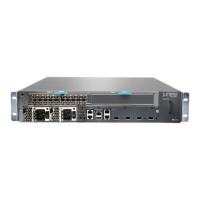CHAPTER 17
Initially Configuring the MX5, MX10, MX40,
and MX80 Routers
•
Initially Configuring MX5, MX10, MX40, and MX80 Routers on page 101
Initially Configuring MX5, MX10, MX40, and MX80 Routers
The MX5, MX10, MX40, and MX80 routers are shipped with the Junos operating system
(OS) preinstalled and ready to be configured when the router is powered on. Two 4-GB
internal NAND flash devices (da0 and da1) are located on the baseboard. The USB storage
device (da2) can be inserted into the slot in the front panel faceplate. The two NAND
flash devices act as the primary boot device (da0) and hard drive (da1).
When the router boots, it first attempts to start the image on the USB flash drive. If a
USB flash drive is not inserted into the router or the attempt otherwise fails, the router
next tries the primary boot device, and then tries the secondary boot device.
You configure the router by issuing Junos OS command-line interface (CLI) commands,
either on a console device attached to the Routing Engine CONSOLE port on the front
panel, or over a telnet connection to a network connected to the Routing Engine
ETHERNET port on the front panel.
Gather the following information before configuring the router:
•
Name the router will use on the network
•
Domain name the router will use
•
IP address and prefix length information for the Ethernet interface
•
IP address of a default router
•
IP address of a DNS server
•
Password for the root user
101Copyright © 2017, Juniper Networks, Inc.

